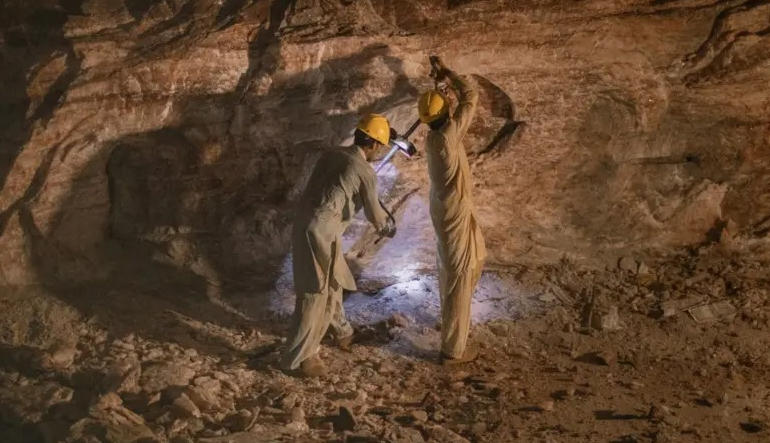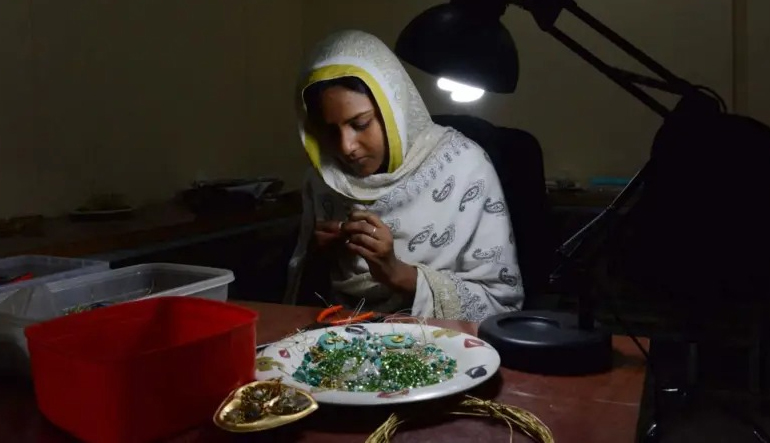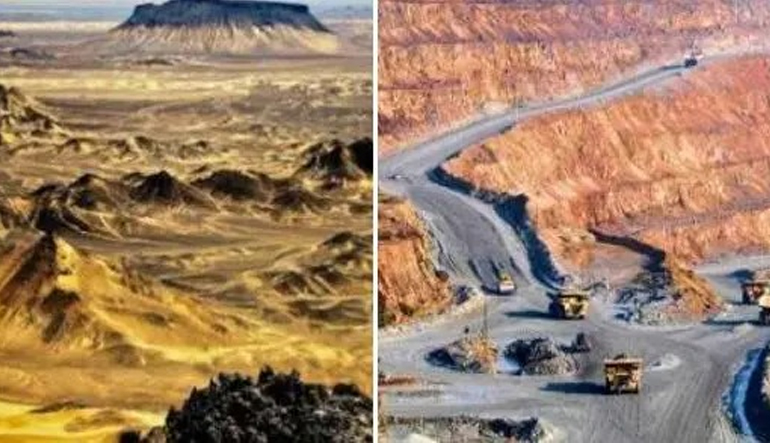

In the dry and dusty windswept region of Chaghi in Pakistan’s province of Balochistan, some of the world’s most valuable mineral resources are hidden—significant copper and gold reserves. The country’s political and military leadership believes these resources could attract billions of dollars in investment. Following Reko Diq and Saindak, there have recently been new claims of discoveries in Chaghi. A private company, National Resources Limited (NRL), which has been awarded the contract to explore regional minerals, claims to have recently discovered new copper and gold deposits in Chaghi. At the Pakistan Minerals Investment Forum 2025 last week, NRL stated that there are clear signs of mineral wealth in the Tang Kor area of Chaghi. The company’s head, Mohammad Ali Tabba, said that international experts and investors would participate in this major project. At the same event, Mari Petroleum (Mari Energies) announced the discovery of new gas and oil reserves in North Waziristan, Khyber Pakhtunkhwa. According to Mari Energies, this is the fourth discovery in the region, with testing revealing 70 million cubic feet of gas and 310 barrels of condensate per day. During this two-day conference, Pakistan and Turkey’s state-owned companies also signed an agreement to jointly bid for offshore oil and gas exploration. Under this agreement, Pakistan’s three major companies—Mari Energies, OGDCL, and PPL—will collaborate with Turkey’s state-owned company to explore resources in marine areas. Officials claim that Pakistan’s mineral wealth has remained untapped due to bureaucratic hurdles, security concerns, and, at times, a lack of political focus. However, just last week, the Pakistani government once again expressed its commitment to utilizing these valuable resources to revive the national economy. The minerals conference held in Islamabad saw participation from delegates, representatives, and investors from over 20 countries, including the United States, China, and Saudi Arabia. These attendees came to explore investment opportunities in Pakistan’s mineral sector, which the government refers to as a “trillion-dollar sector.” The conference aimed to rebrand Pakistan as a key player in the global market, especially in the extraction of what are called "critical minerals" worldwide. Senior government officials, including Pakistan’s military leadership, hailed the conference as a milestone for the country’s economy. However, critics are quick to point out that this is not the first time Pakistan has made grand promises of turning “rocks into gold.” But will these promises remain just that, or will they finally lead to real progress? Before diving into that debate, let’s first understand which valuable minerals are found in Pakistan—and where.
Pakistan categorizes its minerals into different types. Strategic minerals include copper, gold, lithium, rare earth elements, and chromite, which are used in electronics, defense, and green technologies. These minerals hold great appeal for national security and international investment. Energy minerals such as coal and uranium are vital for power generation and nuclear programs. Industrial minerals like salt, limestone, gypsum, and barite are widely used in construction and agriculture. Although precious stones are smaller in volume, they are high in value and play a significant role in export earnings.
The conflict-ridden province of Balochistan in Pakistan holds some of the country's richest and most valuable mineral resources. Most of these are strategic minerals, making Balochistan the mineral hub of Pakistan. In the 1970s, the Geological Survey of Pakistan (GSP) identified gold and copper reserves in Reko Diq and Saindak. Located in the Chaghi district, the Reko Diq deposits are often referred to as a “sleeping giant.” Decades ago, GSP traced potential gold reserves in this region, but the project was stalled for years due to legal and financial disputes. It is now being revived under the leadership of the Canadian company Barrick Gold. In late 2022, a new agreement relaunched the project. Under this deal, the Balochistan government was given a 25% share, the federal government also received 25%, and Barrick Gold was awarded 50%. The company committed to invest and begin production by the end of this decade. Today, the red mountains of Reko Diq, once dormant, are once again bustling with excavation and survey activities. Officials are hopeful that production will commence by 2028, and current efforts are focused on raising investment for the project. According to local media, Saudi company Manara Minerals is a potential investor. Barrick Gold Corporation’s CEO, Mark Bristow, has stated that upon completion of the second phase, the Reko Diq project will have the capacity to produce 400,000 tons of copper annually. He added that the first phase of the mining operation will require $5.5 billion in development expenses, and by 2028, the mine is expected to produce 200,000 tons of copper concentrate and 250,000 ounces of gold annually. Bristow also highlighted the growing global demand for copper, driven by the rise in electric vehicle battery production, the expansion of renewable energy, and increasing electricity needs. He said that increased copper production from Pakistan would yield significant economic benefits for the country. Nearby in Saindak, the sight of blue plants against golden hills has become a normal part of the local landscape. Discovered in 1973, the copper and gold reserves in Saindak marked Pakistan’s first major metallic mining venture. It is estimated that the area holds hundreds of millions of tons of raw material, and the project is currently operated by a Chinese company. Balochistan is not limited to just gold and copper. The province hosts dozens of other mineral types. In the Muslim Bagh region of Qila Saifullah, chromite has been mined for centuries; it's a key ingredient in stainless steel production. More recently, claims of lithium and rare earth elements have emerged from Chaghi and Khuzdar, which the government considers highly strategic minerals. In the 1960s, the GSP discovered large barite deposits in Khuzdar, which are used in oil and gas drilling. Nearby, around Qalat and Mastung, fluorite reserves have also been found in the same rock formations. In Lasbela, a lead and zinc mine—Pakistan’s first modern lead-zinc project—was discovered by the GSP and developed with Chinese assistance. It now produces lead and zinc from underground operations. Coal reserves are also found in the Sori Range–Daghari, Duki, Mach, and Khost areas of Balochistan. Though smaller and lower in energy compared to those in Punjab and Sindh, these coalfields have powered local industries and the railway system for decades and continue to employ thousands of laborers. However, residents often complain that they do not receive a fair share of the benefits from these resources. Lack of transparency in projects is also frequently cited, which many believe is a major cause of unrest and resistance in Balochistan.

‘The Rekodic project has the capacity to produce 400,000 tons of copper annually upon completion of the second phase’
Apart from Balochistan, other provinces of Pakistan also possess vast mineral reserves. During the Minerals Conference held last year, the government claimed that large-scale deposits of gas and several minerals were discovered, particularly in various regions of Khyber Pakhtunkhwa, which will be explored further. It is worth noting that the Mines and Minerals Bill in Khyber Pakhtunkhwa has recently become a controversial issue. A briefing on the bill was postponed on the instructions of former Prime Minister Imran Khan, while both the ruling Pakistan Tehreek-e-Insaf (PTI) and opposition leaders have expressed reservations about it. Beneath the lush valleys and towering mountains of Khyber Pakhtunkhwa lie precious stones that continue to amaze gemologists around the world. The emeralds of Swat are held in high regard in the world of fine jewelry. Even today, locals still sift through rivers hoping to find a gleaming green stone. In recent years, large-scale exploration activities have reportedly been carried out in former FATA areas such as North Waziristan. Last year, Mari Petroleum Company claimed the presence of significant gas reserves in the Shiva region. According to officials, beyond Swat, several new gemstones have been discovered in Khyber Pakhtunkhwa, Gilgit-Baltistan, and Azad Jammu and Kashmir: ruby in Hunza, pink topaz in Katlang (Mardan), aquamarine in Chitral, green peridot in Kohistan, and neelum in Neelum Valley. Pakistan is one of the few countries in the world where naturally occurring peridot is found. However, the minerals of Khyber Pakhtunkhwa are not limited to gemstones. Chromite is found in Mohmand and Waziristan, phosphate for fertilizers in Hazara, soapstone and mica in Sherwan, and iron ore in Malakand and Haripur. Officials claim that signs of copper and gold have also been found in the Shinkai area of Waziristan, which the government is now attempting to explore. After the discovery of oil and gas in Kohat, exploration activities have increased there as well. Meanwhile, coal mining continues in Hangu and Karak. Khyber Pakhtunkhwa is also a major player in the marble industry. Swat's white marble and Mohmand's "Ziarat White" are famous across the country. The mining and polishing of these stones provide employment to thousands of people. To organize mining regions, the provincial government has established Mineral Economic Zones. However, the new bill has sparked controversy by proposing the formation of a new authority that would regulate licensing and exploration in the province.

While Sindh may not be a mineral hub like Balochistan, it holds one of the world’s largest coal reserves. The Tharparkar region is home to the seventh-largest lignite coal reserves globally, which power several electricity projects. Under the China-Pakistan Economic Corridor (CPEC), Chinese companies are investing heavily in coal mining and power generation in Thar. In addition, several public-private partnership projects are underway. According to official data, Sindh has an estimated 185 billion tons of coal. Besides coal, Sindh also has other important minerals such as gypsum, limestone, salt, and granite. The hills of Nagarparkar are known for producing white and pink building stones, which are widely used in construction. Sindh also plays a key role in Pakistan’s oil and gas sector, especially due to the Mari Gas Fields, making the province a vital center for energy production. In Punjab, minerals such as salt, gypsum, and coal are found in the Salt Range, which spans areas like Chakwal, Jhelum, and Khushab. The region is home to the world-renowned Khewra Salt Mine, the second-largest salt mine globally. Additionally, Chiniot has been identified as a source of high-quality iron ore, with traces of copper and gold also present. The limestone and phosphate found in Punjab are used in construction and fertilizer production, respectively.
Eric Meyer, a senior official from the U.S. Department of State’s Bureau of South and Central Asian Affairs, expressed American interest in investing in Pakistan’s mineral sector on the sidelines of the Pakistan Minerals Investment Forum. In a statement issued by the U.S. Embassy in Islamabad, Meyer said, “President Trump has made it clear that securing diverse and reliable sources of these materials (minerals) is a strategic priority.” He added that the United States is working with international partners and Pakistani stakeholders to explore opportunities for investment, technical cooperation, and responsible resource management in the sector. While the exact number and nature of MoUs (Memorandums of Understanding) signed with foreign companies during the conference were not disclosed, local media reports suggest that over ten MoUs were signed between Pakistani and international companies. The government had earlier stated that multiple agreements would be finalized during the event. The conference saw Canadian company Barrick Gold, associated with the Reko Diq project, seeking approximately $2 billion in funding from global institutions and investors. Meanwhile, the U.S. signaled interest, joining China, which already has a strong presence in the sector through the Belt and Road Initiative. However, experts have raised questions about whether the government's efforts to introduce a new regulatory framework in the sector will yield tangible results. Currently, the mining industry contributes slightly over 3% to Pakistan’s GDP. According to analysts, bureaucratic red tape, legal complications, and a lack of transparency in licensing continue to hinder the growth of the sector. Even projects considered success stories, like Saindak, have faced persistent issues and controversies. Analyst Durdana Najam noted, “While the government appears committed, the assumption that this sector alone can end Pakistan’s reliance on the IMF seems overly optimistic. The minerals sector currently contributes only 3.2% to the GDP. Announcements and conferences alone won’t make it the foundation for economic self-reliance.”
It is worth noting that Pakistan held its first-ever Minerals Summit in 2023, which was attended by major global investors such as Barrick Gold, Rio Tinto, and BHP Billiton. According to analyst Durdana Najam, the real challenge lies in Pakistan’s business environment. She points out that investors repeatedly cite issues like regulatory uncertainty, licensing delays, security risks (especially in areas like Balochistan), and a complex tax system as deterrents to investing in the country. Najam emphasizes that if Pakistan truly wants to activate its mining sector, conferences and project announcements are not enough. She suggests three urgent steps:
Ensuring political harmony and stability across provinces;
Improving security in resource-rich areas with the active involvement of local communities;
Promoting transparency in licensing, environmental regulations, and profit-sharing to earn investor trust.
Senior analyst Zahid Hussain echoes similar concerns. He says that before attracting foreign investment, Pakistan must first remove structural barriers. He believes that Pakistan is hopeful for American investment in rare earth minerals, which could help strengthen U.S.-Pakistan relations beyond security cooperation. However, major hurdles must be addressed beforehand. Durdana Najam also noted that while the creation of the Special Investment Facilitation Council (SIFC) gives an impression of fast-track solutions, some analysts caution that relying on unelected bodies like the SIFC—despite their efficiency—raises serious questions about provincial autonomy. Interestingly, the Chief Minister of Khyber Pakhtunkhwa did not attend the 2025 Minerals Conference at a time when the province’s assembly was actively debating the Mines and Minerals Act. Political parties in the province argue that the authority being formed under this Act could allow the federal government to undermine provincial control over local resources. Meanwhile, local communities in resource-rich regions like Balochistan and Gilgit-Baltistan continue to demand a greater share in profits, transparency in agreements, and the protection of their lands and cultural heritage. Analysts warn that increasing security concerns, including Balochistan’s insurgency and the resurgence of militant groups in KP, remain significant obstacles to foreign investment. They argue that without security and political stability, institutions like SIFC and conferences alone will not convince investors to commit. Nevertheless, during the same conference, Pakistan’s Chief of Army Staff, General Asim Munir, reassured attendees that investors and their projects would receive full security. He stated, “The Pakistan Army will ensure a strong security framework and take preemptive measures to protect investor confidence and interests.” “You can trust Pakistan as a reliable partner,” he added.

Powered by Froala Editor